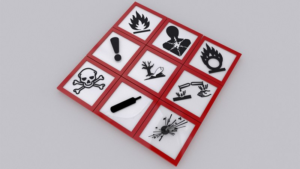Our Hazardous Substances Courses
Hazard symbols are there to alert people to the presence of a potentially harmful substance. In 2015, 17% of workers in the EU were exposed to chemical products for at least a quarter of their working hours, with 15% regularly breathing in the resulting fumes and dusts. The potential for long-term damage to these workers’ health is dangerously high, so it’s important for everyone to be familiar with the different kinds of hazardous substances and how these should be handled in a working environment.
The old European symbols were phased out and replaced with the CLP (Classification, Labelling and Packaging) pictograms in 2015, which are harmonised with international hazard symbol usage. Some are similar to their equivalent symbols under the previous system, but there are differences, so it is important to be clear about which each one means – especially for workers who use hazardous substances in any part of their job.
The symbols are very useful for working out which substances are potentially harmful, which is vital information when writing COSHH risk assessments.
Flammable (Flame) – Products labelled as flammable are at a particularly high risk of catching fire. Petrol is one example, though it is important to remember that many materials – whether labelled as flammable or not – can pose a fire risk under the right conditions. All flammable products should be kept as far away as possible from any spark that could ignite a fire.
Oxidising (Flame over circle) – These substances can react violently with other substances and can cause, or feed, a fire. Bleach falls into this category.
Potential warnings include “keep away from heat” and “wear protective gloves”. Specific information should be on the product label or included in the relevant MSDS (material safety data sheet).
Explosives (Explosion) – Fireworks and certain types of ammunition can cause explosions if not handled correctly. Often substances labelled with this symbol require specialist care and should always be kept away from heat sources such as open flames.

Gas under pressure (Gas cylinder) – Often found in medical or scientific workplaces, these substances can cause explosions if heated. In other cases, containers marked with this symbol may contain refrigerated gas, which can cause cryogenic burns.
These substances might need to be kept out of direct sunlight or away from sources of heat and should always be handled with care.
Toxic (Skull and crossbones) – Materials marked with this ominous symbol pose the most serious of health risks. Swallowing, ingesting or coming into contact with them with bare skin can all prove fatal. Emergency medical care should be sought immediately if this happens.
Serious/long term health hazard (Human silhouette with white star shape) – Turpentine and certain oils can cause severe and long-term health issues if swallowed. Any substances that can cause cancer, respiratory diseases, damage to a pregnant person or their unborn child or genetic defects should have this label on their container.
Advice may include avoiding swallowing or breathing in the product, cleaning any surface it contacts thoroughly after use and avoiding it entirely for people with particular medical conditions.
Health hazard (Exclamation mark) – Materials marked with this symbol are potential irritants or can cause other health issues, such as drowsiness or respiratory problems. Substances which can cause damage to health when they come into contact with the skin, or are inhaled or swallowed, are included.
Many day to day cleaning products have this warning on their labels.
Corrosive (Substance burning hand and surface) – Substances labelled with the Corrosive symbol can cause damage to materials such as metal and severe injuries when they come into contact with someone, particularly the skin and eyes.
Lots of acids are corrosive, as well as drain cleaners and ammonia. These substances should be handled with extreme care and all necessary Personal Protective Equipment (PPE) should be worn.
Environmental Hazard (Dead fish and tree) – This symbol is attributed to substances that pose a significant danger to the environment. For example, they may be hazardous to aquatic life and have the potential to cause long-term harm.
Pesticides and fuel may fall under this banner and need to be disposed of with extra care.
Hazardous Substances in the Workplace
It’s important that all staff are trained to recognise hazardous substances and how to handle them safely. Refresher training is particularly vital in this case, as the pre-2015 orange and black symbols differ from the new pictograms introduced by the CLP Regulation and workers need to recognise the new system.


